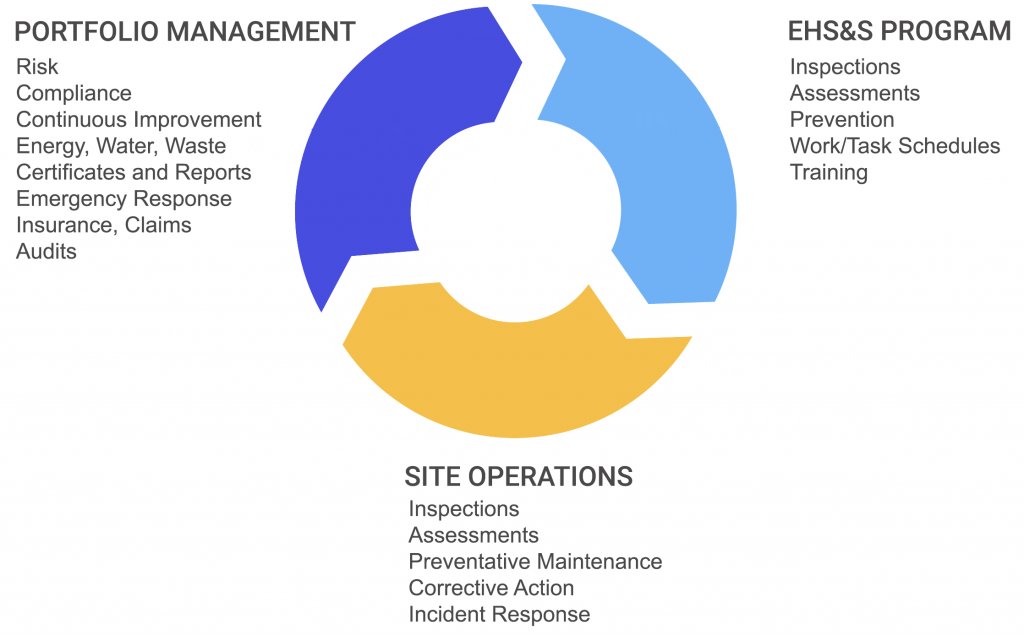EHS Management Software
What is EHS Management Software?
Many companies are required to comply with regulations that protect the environment from contamination, and to ensure the safety of employees, service providers and occupants of buildings. Environmental, Health and Safety (EHS) management software helps companies manage the information and activities required to sustainably achieve regulatory compliance.
These enterprise software platforms provide a structured information management framework that keeps operational procedures consistent with corporate policies and compliant with EHS regulations.
Refined Data is an example of enterprise EHS Management Software specifically designed for real estate investors and management companies.
Who Uses EHS Software?
Risk and safety management procedures are conducted by the property managers and site operations teams at every facility. These individuals use EHS software to complete the many operational activities related to EHS programs such as safety and compliance inspections or preventative tasks designed to reduce the risk of environmental contamination or human injury.
Corporate responsibility for EHS regulatory compliance typically resides with senior compliance officers or with directors of risk or health and safety. This level of management relies on EHS management software to monitor the overall performance of risk, safety and compliance programs.
C-level leaders are unlikely to personally use EHS platforms, but executive support is a crucial factor for the successful implementation and adoption of software. CFO’s and COO’s will be aware of the efficiency gains and reduction in operating costs that can be achieved with the successful implementation of operationally focussed EHS management software.
How is EHS Management Software Used?
EHS management software is used not only as an information repository, but also to automate many of the following activities:
- Identify, prioritize, and manage risks.
- Conduct safety inspections and audits.
- Collect risk and safety reports, assessments, safety certificates, and correspondence.
- Capture incident reports and resulting insurance claims.
- Use historic data to improve EHS program performance.
- Support property and liability insurance renewals.
- Provide input to quarterly investor reports and for site business plans.

Why Use Software to Manage Risk, Safety and Compliance?
Many companies operate their EHS programs using document repositories, spreadsheets, and paper-based checklists. This less formal approach requires more management and audit oversight to verify that EHS policies and procedures are effectively implemented; this approach is hard to scale as the number of buildings and employees increases.
However, by dedicating resources and implementing enterprise software for the management of EHS, real estate leadership teams clearly signal that safety, compliance, and data governance are an important corporate commitment. This commitment signals a level of maturity that investors expect of segment leaders and is equally important for companies looking to attract and retain talented employees.
For the operational aspects of risk and compliance management, EHS software provides a platform for transparency, consistency, continuity, engagement, and continuous improvement that is hard to achieve and sustain without the benefits of enterprise information management software.
Another important consideration for using best of breed EHS software is that operations teams are by far the largest segment of a real estate workforce. Operational efficiency gains in this area of real estate are materially significant, producing immediate improvements in workforce collaboration, communication, employee engagement, business continuity, and information management. These benefits are most evident when the software supports a management by exception strategy, efficiently focussing employees on those issues that require their attention. In any compliance based discipline, errors and omissions in information management are a source of risk that could result in regulatory non-compliance, fines, or damage to brand and reputation.
EHS software further enhances an organizations ability to implement continuous improvement into risk and safety management programs. While continuous improvement is absolutely possible without the use of EHS management software, a software-based approach provides a continuous history of complete and consistently classified information with significantly less administrative overhead. Efficient information and people management systems are key differentiators between organizations that are reactive and organizations that remain responsive, resilient, and innovative in the face of evolving market and regulatory changes.

What are the Benefits of Enterprise EHS Management Software?
- Create a culture of performance, collaboration, transparency and efficiency.
- Manage large organizations with a management by exception strategy.
- Reduce the risk and cost of employee turnover.
- Focus employees on critical objectives and responsibilities.
- Coordinate a distributed workforce with actionable information and connected workflows.
- Minimize or eliminate information silos.
- Provide efficient data-driven workflows feeding rapid cycles of continuous improvement.
- Support an ISO compliant EHS management program.

ISO Management Standards Supported by EHS Software
Please refer to the following page for an overview of ISO standards for EHS and to ESG management…